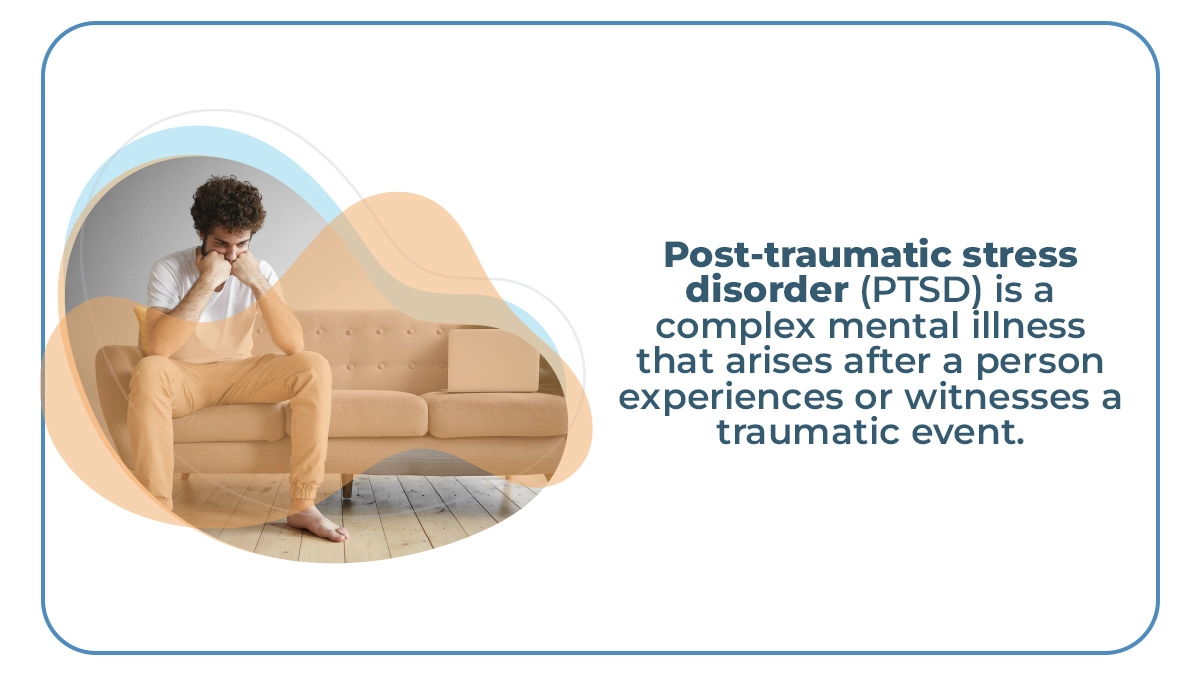What Is Post-traumatic Stress Disorder (PTSD)?
Post-traumatic stress disorder, or PTSD, is a mental health condition that can develop after experiencing a terrifying or life-threatening event. This can include situations like combat exposure, natural disasters, car accidents, or physical or sexual assault.
PTSD can profoundly affect an individual’s life, impacting relationships, work, and overall well-being. However, there is hope. Various treatment options are available to help individuals heal from trauma and reclaim control of their lives.
Key Takeaways
PTSD, a mental health disorder, develops after experiencing a terrifying or life-threatening event. Here is what you need to know:
- PTSD involves a range of symptoms that develop after exposure to trauma, affecting different aspects of a person’s life.
- PTSD can manifest in various forms, each with its own distinct set of symptoms and triggers.
- Effective treatment options for PTSD are available, offering hope for symptom management and recovery.
Reach out to The Recovery Team at (800) 817-1247 for comprehensive mental health treatment and support to reclaim your life.
Understanding Post-Traumatic Stress Disorder (PTSD)
Post-traumatic stress disorder (PTSD), a multifaceted mental disorder, develops when someone experiences or witnesses a traumatic or life-threatening event. It can affect people of all ages. It can deeply affect a person’s ability to function normally in daily life and can lead to great distress if left untreated.
Symptoms of PTSD
Symptoms of post-traumatic stress disorder (PTSD) can vary widely among individuals but commonly include:
- Flashbacks: Vivid, intrusive memories of the traumatic event.
- Nightmares: Recurrent, distressing dreams related to the traumatic experience.
- Intrusive Thoughts: Distressing thoughts or images related to the trauma that intrude upon consciousness.
- Avoidance: Efforts to avoid reminders of the traumatic event, including places, people, or activities that may trigger memories.
- Hyperarousal: Feeling constantly on edge, easily startled, or experiencing heightened anxiety.
- Negative Changes in Mood or Thinking: Consistent negative and confusing thoughts, distorted beliefs about oneself or the world, and feelings of detachment or estrangement from others.
- Hypervigilance: Being overly aware of potential threats, often leading to irritability or angry outbursts.
- Emotional Numbness: Difficulty experiencing positive emotions and feeling emotionally disconnected from others.
- Difficulty Concentrating: Significant problems with memory, attention, or concentration.
Causes of PTSD
The causes and risk factors of PTSD are multifaceted and can include:
- Direct Trauma Exposure: Experiencing or witnessing a traumatic event firsthand, such as combat, natural disasters, accidents, or physical/sexual assault.
- Repeated Exposure to Trauma: Individuals working in professions like emergency services, law enforcement, or healthcare may develop PTSD due to repeated exposure to traumatic events.
- Childhood Trauma: Upsetting experiences during childhood, such as child abuse, neglect, or household dysfunction, can increase the risk of developing PTSD later in life.
- Biological Factors: Genetic predisposition and alterations in brain chemistry and structure may contribute to the development of PTSD.
- Psychological Factors: Pre-existing mental health conditions, such as anxiety or depression, can elevate the likelihood of developing PTSD after a traumatic event.
- Lack of Social Support: A lack of support from friends, family, or the community following a shocking event can make it more difficult for individuals to cope and increase the likelihood of developing PTSD.
- Other Life Stressors: Ongoing stressors such as financial difficulties, relationship problems, unexpected death of a loved one, or chronic illness can exacerbate symptoms of PTSD.
Remember, not every person who experiences a traumatic event will develop PTSD, and the intensity of symptoms can vary widely among individuals.
Types of Post-Traumatic Stress Disorder (PTSD)
Post-traumatic stress disorder (PTSD) manifests in various forms, each with distinct characteristics and impacts on individuals. Here’s an overview of different types:
Normal Stress Response
This is a common reaction to a traumatic situation that typically resolves over time without developing into full-blown PTSD. Symptoms may include heightened anxiety, flashbacks, or intrusive thoughts, but they usually diminish as the individual processes the experience.
Acute Stress Disorder (ASD)
ASD occurs within the first month after exposure to a traumatic event and shares many symptoms with PTSD. However, ASD symptoms typically last from three days to one month, whereas PTSD symptoms persist for longer periods.
Complex PTSD
Complex PTSD (C-PTSD) often results from prolonged, repetitive trauma, such as childhood abuse or domestic violence. In addition to typical PTSD symptoms, individuals with C-PTSD may experience difficulties with emotion regulation, interpersonal relationships, and self-perception.
Dissociative PTSD
Dissociative symptoms involve a disconnection between thoughts, emotions, and identity. Individuals with dissociative PTSD may experience depersonalization (feeling detached from oneself) or derealization (feeling detached from the world around them) in addition to other PTSD symptoms.
Uncomplicated PTSD
This is the classic form of PTSD, marked by signs such as upsetting memories, nightmares, hypervigilance, and avoidance behavior. It typically arises after exposure to a single traumatic event.
Comorbid PTSD
Comorbid PTSD refers to cases where PTSD occurs alongside other mental disorders, such as depression, anxiety disorders, substance use disorders (SUDs), or personality disorders. These co-occurring conditions can complicate treatment and may require a tailored approach.
Secondary Traumatic Stress (STS)
Also known as vicarious trauma, STS can affect individuals who are indirectly exposed to different types of trauma through their work or relationships, such as first responders, mental health professionals, or caregivers. It can lead to similar symptoms of PTSD.
Each type of PTSD may require different treatment approaches and interventions tailored to address the specific symptoms and needs of the individual.
Impact of Post-traumatic Stress Disorder (PTSD)
Living with post-traumatic stress disorder (PTSD) can have a significant impact on various aspects of an individual’s life. Here’s the breakdown of the effects of PTSD:
Mental Health
PTSD can lead to significant mental health problems, including persistent anxiety, depression, and mood swings. Individuals with PTSD experience intrusive thoughts, flashbacks, and nightmares related to the distressing event, which can interfere with their ability to concentrate and sleep. Feelings of guilt, shame, and hopelessness are also common among those with PTSD, contributing to a diminished sense of self-worth and overall quality of life.
Physical Health
PTSD is not only a condition of the mind but can also take a toll on physical health. The chronic stress and anxiety associated with PTSD can contribute to several physical health problems, including cardiovascular issues, chronic pain, and gastrointestinal disorders. Additionally, individuals with PTSD may engage in unhealthy coping mechanisms such as substance abuse, further exacerbating physical health problems.
Social Life
PTSD can strain relationships and impact social interactions. Individuals may have difficulty trusting others, avoiding social situations, or becoming irritable or aggressive. This can result in social withdrawal and isolation, making it hard to maintain meaningful connections with friends, family, and colleagues. As a result, individuals with PTSD may feel disconnected from their support systems, exacerbating feelings of loneliness and alienation.
Early intervention and comprehensive treatment approaches that address the complex interplay of these effects are essential for mitigating the long-term consequences of PTSD.
Treatment Options for PTSD
Effective treatments for PTSD are available to help people manage symptoms and enhance their quality of life. Here are the most common treatment options for PTSD:
Psychotherapy (Talk Therapy)
Psychotherapy is often considered the cornerstone of PTSD treatment. Scientifically proven therapies such as trauma-focused cognitive behavioral therapy (TF-CBT), cognitive processing therapy (CPT), and eye movement desensitization and reprocessing (EMDR) are commonly used. These effective psychotherapies help individuals process traumatic memories, challenge distorted beliefs, and develop coping strategies to manage different types of PTSD symptoms.
Medication
Medications can also be beneficial in treating PTSD, particularly in alleviating symptoms such as depression, anxiety, and insomnia. Antidepressant medications, such as selective serotonin reuptake inhibitors (SSRIs) and serotonin-norepinephrine reuptake inhibitors (SNRIs), are commonly prescribed to help regulate mood and lessen symptoms of hyperarousal.
Anti-anxiety medications may also be used on a short-term basis, but their long-term use is generally discouraged due to the risk of dependence and other side effects.
Mind-Body Therapies
Mind-body therapies such as yoga, meditation, and mindfulness-based stress reduction (MBSR) can complement traditional treatments by promoting relaxation, reducing stress, and increasing emotional resilience. These therapies focus on the connection between mind and body, helping individuals regulate their emotions and cope with symptoms of PTSD.
Family Therapy
Family therapy can also play a vital role in PTSD treatment by improving communication, strengthening relationships, and fostering a supportive environment for healing. By involving family members in therapy, individuals with PTSD can receive additional social support and learn effective coping strategies that can enhance their overall recovery.
Support Groups
Support groups offer a valuable opportunity for individuals with PTSD to connect with others who have shared experiences. Peer support can foster a sense of belonging, decrease feelings of isolation, and provide practical advice and encouragement in navigating the challenges of living with PTSD.
A combination of these treatment approaches tailored to the individual’s needs often harvests the best results in managing PTSD symptoms and improving quality of life.
Living With PTSD
Living with PTSD can be challenging, but with the right strategies and support, individuals can lead fulfilling lives despite their symptoms. Here are some key aspects to consider:
Healthy Lifestyle Changes
Making healthy lifestyle changes can positively impact a person’s ability to manage PTSD symptoms. This includes regular exercise, eating a well-balanced diet, getting enough sleep, and avoiding addictive substances like alcohol and drugs, which can exacerbate symptoms. Engaging in activities that promote relaxation and stress reduction, such as meditation or spending time in nature, can also be beneficial.
Coping Strategies
Developing effective coping strategies is essential for managing PTSD symptoms and lessening their impact on daily life. This may involve learning techniques to manage stress, such as deep breath exercises or progressive muscle relaxation. Engaging in enjoyable activities, practicing self-care, and setting realistic goals can also help individuals cope with the challenges of living with PTSD.
Support for Family Members
PTSD affects the individual experiencing it and their family members and loved ones. Providing education and support for family members can help them better understand PTSD and learn how to offer meaningful support. Encouraging open communication, setting boundaries, and seeking professional help can strengthen relationships and foster a supportive environment for healing.
By incorporating these elements in daily life, individuals living with PTSD can enhance their overall well-being and quality of life.
Heal From Trauma With The Recovery Team
Struggling with PTSD can feel like navigating through a storm, but you don’t have to weather it alone. At The Recovery Team, we guide you back to calm waters and help you reclaim your life.
Everyone’s journey is unique, so we offer comprehensive mental health care options. Our program includes evidence-based therapies, expert medication management, trauma programs, and holistic approaches to address your unique needs.
Don’t wait any longer to take control of your mental health. Contact us now at (800) 817-1247 to begin your journey toward recovery.






